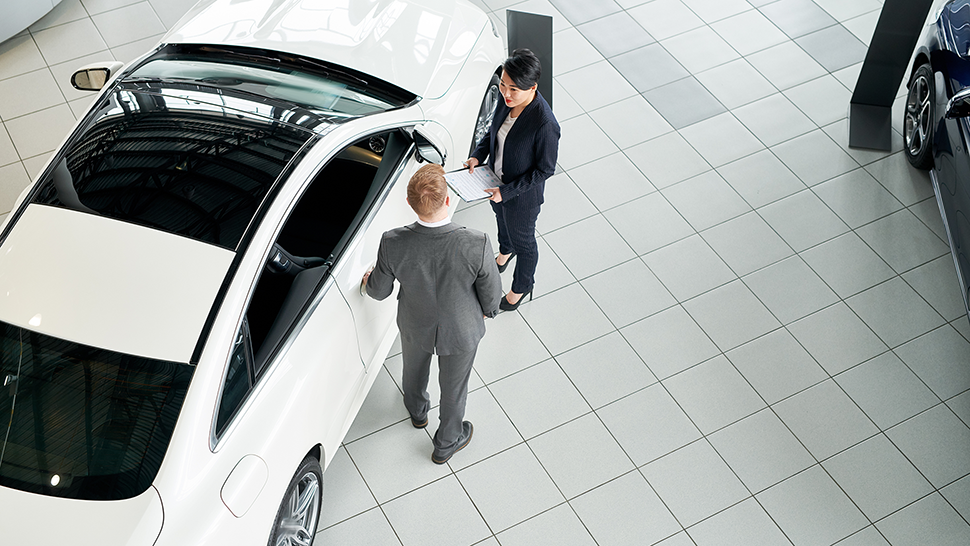How to Improve Your Dealership's Customer Communication
Let's talk about something that, honestly, can make or break your dealership:
Communication
I'm not just talking about answering the phone politely (though that's a start!). I mean the real-deal, communication that keeps customers happy, loyal, and coming back for more.
Think about it. With tech changing everything in the auto industry, clear and effective communication is essential for collaboration between the manufacturers, you the dealership, and your customers. It's a critical piece of awesome customer service.
Sending too many messages, not enough, hitting customers on the wrong channel, or making them repeat themselves five times is a sure way to frustrate your customers. But get it right, listen to their preferences, and use the right tools is how you build positive, long-term connections.
And here's something else: your communication is your dealership's brand out in the wild. In a market where it's tough to stand out, how you talk and write about your dealership is just as important as your logo or the color of your building.
Do you want to bland out or stand out?
Your communication strategy is basically you telling the world (and your customers) what you're all about.
Table of Contents
Before fixing anything, you need to understand the lay of the land. You need to be engaging with your customers at every step of their journey with you. And guess what? Different folks want different kinds of communication at different times.
Getting a handle on these stages helps you put the customer in the center of how you talk to them.
First Contact
Whether they're walking up to the front desk or browsing the sales floor, that first interaction is huge. It sets the whole tone. This is your chance to make a positive selling statement, sure, but more importantly, to be super alert to what the customer is actually interested in. It's about that initial approach and starting to gather what they're looking for, what problems they need solved.
The Service Experience
Communication during a service visit is absolutely crucial. We're talking about everything from scheduling the appointment to giving them updates on how the maintenance is going, and getting their thumbs-up for any estimates. This is where real-time communication is gold. Keeping them posted on timelines and costs. And with the right dealership tool you can even set automations for when a customer might need service based on their car's history and how they use it. That means you can be proactive, reaching out with maintenance reminders or sweet service deals before they even think to call you.
Post-Visit
The conversation doesn't end when they drive off the lot or pick up their keys. Following up after a purchase or service is vital. This is your chance to get their feedback, maybe ask for a review to boost your online reputation, and just keep that engagement going. Personalized marketing and those timely maintenance reminders we just talked about? That's how you build loyalty that lasts.
Consistency and Personalization
If there's one thing to take away here, it's that personalization is king for building long-term customer loyalty. Customers expect you to send them stuff that's actually relevant, useful, engaging, and personalized. They also want a smooth experience, where it feels like you know who they are no matter if they're on your website, getting a text, or reading an email. Using a mix of good old email and SMS with some of the newer, richer ways to communicate helps you cater to everyone.
Theory is great, but let's get down to business. How do you actually improve this stuff? Let's break it down by those key moments.
- Front Desk & Sales Floor First Impressions: That first hello should be genuinely welcoming and totally professional. Being tuned in to what a customer is interested in and, most importantly, ready to listen is where it all starts.
- Ditch the Script, Keep it Real: You need to be prepared, but nobody wants to talk to a robot reciting lines. The goal is to build relasionships, show some real curiosity, and actually care about what the buyer needs, not just power through a script. Your staff are customer ambassadors. That's a best practice right there.
- Empathy, Clarity, and Being Present: These are your communication superpowers. Empathy is about putting yourself in their shoes, especially if they're frustrated. Clarity means being as clear and specific as you can be. No jargon, no confusion. And presence? That's all about active listening, really hearing what they're saying.
- Train Your Team: Your team needs to be educated on what great communication looks like. This includes how to use any tools you might have, how to look at data for customer insights, and how to respond quickly and effectively. Training should cover the basics of customer service. Greeting folks, assisting them, and how to handle the tricky or tense situations. Emotional intelligence is about being able to read and manage emotions (yours and theirs). It is huge here. Teaching them to be great active listener means they can focus on the speaker, making eye contact, ditching distractions, and giving feedback so they know you're getting it.
- Real-Time Updates via Text: Text messaging is a powerhouse for service communications. Use it for sending service reminders, quick updates on inspection results with photos or videos, and those "Hey, your car is ready!" notifications.
- Manage Those Expectations: Give customers clear pricing options they can actually understand. It shows you're being upfront and builds massive trust. And if there's a change or a delay? Be proactive. Tell them. Don't make them chase you. Sending clear estimates with photos or videos via SMS is a game-changer here.
- Video Messages for Transparency: A quick video can work wonders. While you might not be live-streaming the oil change, sending a short clip explaining a service need or showing an issue found during the inspection is transparency gold.
- Build Trust by Following Through: This sounds simple, but it's massive. When you say you're going to do something, do it. Successfully getting a task done means being organized, knowing who needs to be in the loop, setting deadlines, and actually wanting to see things through. Delivering on your promises is absolutely essential for customer relationships and that all-important trust.
- Post-Service Communication: Don't let the conversation die after they pick up their car. A simple thank-you, a quick survey to get their feedback (what made them happy, what could be better?), or even a text asking for a review are all crucial. Actively listen on social media too. Plus it can help you adress issues before the CSI surveygoes out.
- Personalized Promotions & Maintenance Reminders: Understanding customer behavior and needs allows you to reach out proactively with customized experiences and targeted promotions that are way more likely to hit the mark.You can set automations to send campaigns based on your custromers past visits and interactions. Personalization seriously increase customer experience and satisfaction and makes them way more likely to come back. And remember, good personalization relies on good data management. Make sure your customer data is clean, accurate, and rich.
- SMS and Email Best Practices: Both email and SMS are vital. For email: clear subject lines, important info first, keep it short, no slang, check your grammar, and remember email is pretty public, so be careful with content. For SMS: know the rules and regulations. TCPA compliance and ethics are non-negotiable here. It's all about using the right channel for the right message.
- Tools for Automation & DMS Integration: Tools like chatbots and virtual assistants can provide instant answers to common questions, cutting down response times and freeing up your team to focus on more complex interactions. Customers are increasingly comfortable with chat-based support, especially for quick updates, appointment confirmations, and simple troubleshooting. Kimoby is a great example of a platform designed specifically for dealerships and auto service businesses. It offers powerful SMS automation, real-time service updates, video messaging, and review requests all integrated directly with your DMS. With Kimoby, you can send personalized service reminders, automate follow-ups, and even trigger messages based on vehicle status or customer behavior, without manual effort.
- Online Reputation Management: Be ready to respond quickly and professionally to any online reviews, especially the ones that show you where you can improve. Social media and review sites are where these conversations happen. Actively asking for feedback helps you manage this.
There you have it. Effective communication at every single stage of that customer journey is absolutely vital for keeping customers happy and loyal. This whole digital transformation is giving you the tools to provide faster, more efficient, and way more personalized service than ever before.
Remember thhe key moments from the first handshake, to keeping them in the loop during service, to smart, personalized marketing. Every interaction counts.
Think of great communication as the art and heart of meaningful customer connections. It builds trust, it builds loyalty, and yeah, it builds your bottom line.
At the end of the day, making an effort to be more consistent and more thoughtful in how you communicate can make a world of difference.
Strong Communication = Stronger Relationships (and more sales!)
FAQ
How to Promote Good Customer Service
Great customer service now blends modern efficiency with genuine care. Here's how to strike that balance:
-
Use Technology: Use AI and digital tools for dealerships for smoother online booking, instant service updates via text, and quick answers from chatbots. This increase convenience and speed.
-
Personalize the Experience: Use the data you have to understand customer needs, offering relevant service reminders and personalized communications.
-
Master Human Touch: Train your team to truly understand customer needs and communicate professionally and empathetically across all channels (phone, text, in-person).
-
Problem Resolution & Ownership: Empower staff to resolve issues effectively, turning potential negatives into loyalty-building positives.
-
Ensure Strong Teamwork: When your departments collaborate well, the customer experience is seamless.
How Dealerships Can Adapt to Evolving Customers Expectations?
Adapting means being more digital, convenient, and relationship-focused. Key strategies include:
-
Offer Seamless Online Interactions: From easy vehicle research and appointment scheduling to transparent updates, make your digital presence strong and user-friendly.
-
Use Data for Personalized Engagement: Understand individual customer preferences to provide timely, relevant information and offers.
-
Prioritize Speed and Convenience: Reduce friction points in sales and service. Think quick check-ins, efficient communication, and easy payment options.
-
Be Responsive Across All Channels: Make sure customers can reach you easily and get quick, helpful replies whether they use text, email, or phone.
-
Focus on Building Lasting Relationships: Be clear in your communications, pricing, and recommendations.
-
Shift from Transactional to Consultative: Position your team as knowledgeable advisors who are there to help, not just sell.
-
Invest in Your Team: Give your staff the training and tools they need to deliver a modern, customer-centric experience.
You May Also Like
These Related Stories
/Screenshot%202023-04-28%20at%206.11.11%20PM.png)
Using Dealership Texting Software to Improve CLV & Profit

Choosing the Right CRM for Your Car Dealership







